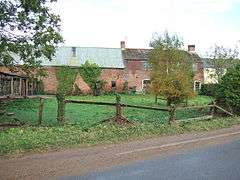Newton, Fenland
Coordinates: 52°42′32″N 0°07′30″E / 52.709°N 0.125°E
Newton (or Newton-in-the-Isle) is a village and civil parish in the Fenland district of north Cambridgeshire, England, four miles to the north of Wisbech. It was formerly also known as Newton in the Isle or Newton on the Isle, where "isle" refers to the Isle of Ely.[1]
History
The village is situated on the Silt Fen, a sea bank formed thousands of years ago. Unlike the salt marshes to the north or the formerly water-logged fens to the south, this narrow strip (also known as the Townland) has been inhabited for many centuries. Its location as a corridor for trade brought wealth to the villages during medieval times in an otherwise relatively poor area.[2]
Newton, however, was not listed in the Domesday Book and was thus probably settled later, with its first mention appearing in 1210.[3]
The College of St Mary by the Sea was founded here during the reign of Henry IV by Sir John Colville. The lands were given to the rectory of Newton when the college was dissolved by Henry VIII.[3]
Church
The parish church of St. James is a medieval structure with a tower. Formerly dedicated to St Katherine, the church was built in the 12th century and widened in the 14th century.
Village life
The village is home to The Woadman Arms public house, deriving its name from the fact that woad was grown in the village until the 19th century. The second public house is called The White Lion and is reputedly haunted.
See also
References
- ↑ Gazetteer of the British Isles (Edinburgh: Bartholomew, 1887)
- ↑ "Newton-in-the-Isle". Cambridgeshire Churches.
- 1 2 "A History of the County of Cambridge and the Isle of Ely: Volume 4: City of Ely; Ely, N. and S. Witchford and Wisbech Hundreds (2002), pp. 201-206". Victoria County History.
External links
![]() Media related to Newton, Fenland at Wikimedia Commons
Media related to Newton, Fenland at Wikimedia Commons

